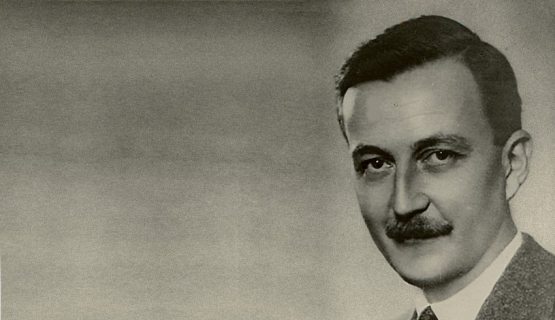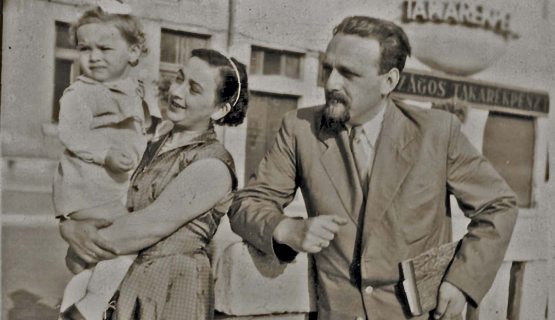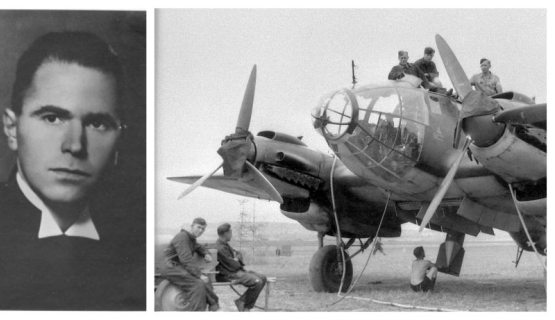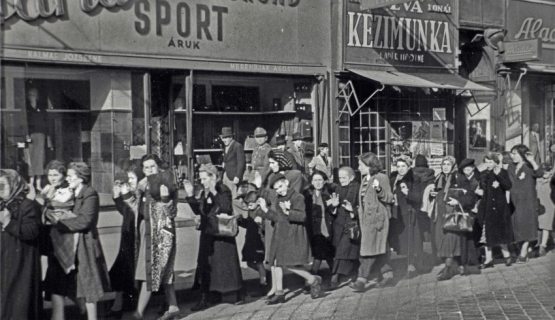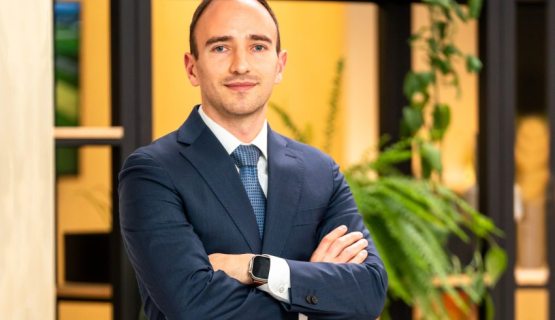Fifteen years in refuge – Unseen chapters from the life of Cardinal József Mindszenty
We know from Hungarian history that a person who has been convicted of treason by both the Arrow Cross and the Communist regimes can only be a patriot. Cardinal József Mindszenty, Prince Primate, Archbishop of Esztergom, was not only a charismatic church leader but a true patriot who served the interests of the country in all circumstances. This iconic figure of the 1956 uprising sought and was granted refuge in the embassy of the United States of America on 4 November, the day the Soviets launched their attack.
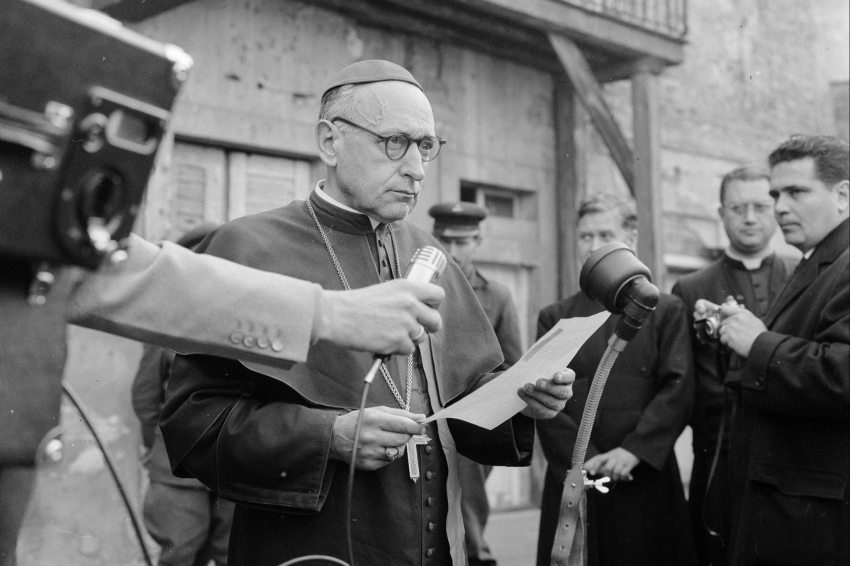
On being freed from imprisonment in Felsőpetény, on 3 November 1956 József Mindszenty gave a speech in the courtyard of the primate’s palace, which was also broadcast by radio - Photo: Fortepan / ETH Zürich
He spent 15 years in the embassy on Szabadság Square. Until recently, we knew little about this period. In 2019, Menedékben (Amerikai diplomaták Mindszenty bíborosról 1957–1970) (In Refuge – American diplomats on Cardinal Mindszenty 1957-1970) was published, the work of András Miklós Deák, Ádám Somorjai OSB and Tibor Zinner. The book uses foreign affairs sources hitherto unpublished in Hungarian and it reveals the everyday life of the cardinal from the viewpoint of American diplomats.
We learn about the life of the embassy from inside, the daily agenda of the cardinal, and his personal and political contacts, all of which serve to nuance the picture we have of Mindszenty, as well as Cold War American-Hungarian relations.
We spoke to two of the authors, Benedictine Father Ádám Somorjai and András Miklós Deák, about the lesser known details of the life of Cardinal Mindszenty.
How did you gain access to English-language sources?
Ádám Somorjai OSB: “The ‘Cardinal Mindszenty’ boxes had already been separated from the archive of the American embassy in Budapest. These files were later despatched to the American State Department. They are currently in the American national archive and were released for study after 30 years. I was there for the first time with my companions of the Benedictine Order in 2009 and we took photographs of the first 2000 pages. In snowy February of 2010, I took pictures of more than 7000 pages of documents together with Margit Balogh, two of her assistants and another fellow of the order. This is how we started.”
What did Cardinal Mindszenty do on 3 November, on the day preceding the Soviet invasion?
Ádám Somorjai OSB: “On the afternoon of Saturday 3 November, he gave an appeal to the nation live from Parliament and then withdrew to Buda, to the primate’s palace. He was woken at dawn: state minister Tildy sent a message that the Russians were on their way and that he should return to Parliament, partly for his own protection and partly for ease of access to updates. By the time he arrived, the ministers had already left. The prince primate wanted to return to Buda but his car had disappeared and Soviet tanks were pouring across Margaret Bridge. Thus he sat down on a bench on the first floor with his secretary. This is where he was seen by Captain Kálmán Tóth, who offered to escort him to the American embassy.”
How did Cardinal Mindszenty manage to get into the embassy? How did the idea of fleeing there from Parliament come about in the first place? Who helped him?
András Miklós Deák: “To this day, these are questions that have not been fully clarified. The mediator must have been a person with high status relations with the Americans, for example, it could have been the Tildy couple. We know for certain that the decision about the cardinal seeking refuge in the American embassy was reached in Parliament. There was no time to consider that the USA was not a Catholic country, furthermore, what the Vatican’s position would be about the refuge.
“We know a little bit more about the American agreement: the under secretary of state Herbert Hoover, Jr. called President Eisenhower, who consented to giving refuge on the recommendation of the State Department. The initiator of the process may have received notification of this decision in Parliament and in this knowledge, Cardinal Mindszenty could then have gone to Gate I closest to Szabadság Square. Ambassador Edward Wailes, head of mission, also received a telegram concerning this matter.
“At this very moment a spanner was thrown into the works because the car was not at the disposal of the cardinal. However, in the certain knowledge of being granted refuge, they decided to risk the walk across to the embassy, a move that was not without danger.
“At 07:58, Mindszenty knocked on the gate. Why is it that we don’t know a little more about this? Because in order to protect the persons concerned in this sensitive matter, the State Department had the telegram despatched to the embassy shredded!”
Why did he ‘only’ receive refuge status and not asylum?
Ádám Somorjai OSB: “The American legal system does not recognize asylum, but it does recognize refuge based on humanitarian considerations. It is granted to those exposed to clear and present danger, for example, by the local residents. Initially, American diplomats used the word ‘asylum’ in their reports but in fact the cardinal ‘only’ received refuge, which, even so, was effective to keep him safe and alive.”
József Mindszenty in the courtyard of the primate’s palace, Buda Castle, after giving his radio address - Photo: Fortepan/ETH Zürich
What were the most important rules regarding his refuge, that is, his stay at the embassy?
András Miklós Deák: “We found the most concise summary of the gradually established rules of refuge always referred to as ‘delicate and exceptional’ in the memorandum of state secretary Dean Rusk to President Kennedy. According to this, they considered it important that the refuge provided by the embassy remain purely humanitarian in nature, without any political weight. They were careful to see that the situation never brought the USA into an awkward position internationally.
“The cardinal could not use the embassy as a base for his political and clerical activities, he was not permitted to give interviews, and he was forbidden from having any correspondence with persons not part of the government of the USA.
“During the years he spent at the embassy, he regularly wrote letters to four presidents, Eisenhower, Kennedy, Johnson, and Nixon and their state secretaries. Only unsealed written messages related to the refuge status of the cardinal or personal spiritual matters were allowed between the cardinal and the Vatican.”
How did he spend his everyday life in ‘refuge’?
Ádám Somorjai OSB: “He was given a two-room apartment with bathroom on the third floor of the embassy. The cardinal celebrated mass every day amidst modest circumstances at his desk. A server attended him on Sundays only. Masses were attended by representatives of the embassy and other interested embassies (Italian, French, Indian, Brazilian), primarily the wives of ambassadors. Occasionally he conducted baptisms if the embassy employee was Catholic. In this case, the military chaplain of the United States issued the birth certificate in Washington. The cardinal was permitted to visit the embassy library, he could read the Hungarian county and foreign language dailies subscribed for him. In addition, he worked on his memoirs.
“Occasionally, over the course of this long refuge, there were more colourful, amusing episodes as well. For example, once when the Hungarian regime organized a demonstration against the Vietnam war in front of the embassy, and protestors ‘spontaneously’ threw ball bearings at the closed shutters of the building, the cardinal, calmly sitting at his desk, stated to the American diplomats concerned about him: ‘I enjoy this symphony of peaceful coexistence’. There was also an occasion when Mindszenty wanted to play a trick on a diplomat visiting him at the electronic door protecting the cardinal, saying that he didn’t want to admit him.”
Who was allowed to visit him?
András Miklós Deák: “Father confessors (Ferenc Városi, later Gyula Tátrai) could pay visits as well as relatives: Mrs. János Pehm (his mother), Teréz Légrádi and Anna Fuksberger (his sisters), his nephews and their families.
“From the Vatican, at official request, Cardinal König paid the first visit and this was followed by many others, on average once a year but in 1967 there were four visits. Secondly, diplomat of the Holy See Agostino Casaroli, after assessing the state of health of the prince primate, only came for a short, one-day visit in 1965 and then never again. Official visitors from the State Department also paid a visit to the cardinal, meanwhile Western diplomats and journalists who also wanted to meet Mindszenty were refused permission.”
Was there anybody among the staff of the embassy who developed a close personal relationship with him?
András Miklós Deák: “The cardinal had close personal contact with several young diplomats assigned to him, in the jargon of the American embassy, ‘religious attachés’. I would mention primarily the Hungarian-speaking Ted Papendorp (1928–1998) who – exactly because of the close personal relationship – was stationed in Budapest for a second time. Close ties developed with those families who attended masses given by the cardinal, or who had him christen their children. An example of the latter is the family of Edward Alexander. Naturally, at the beginning of the refuge those diplomats got close to Mindszenty who could speak the language and translated his letters because they were of Hungarian origin. Géza Katona and Louis Toplosky were in this situation. After they were posted elsewhere, a few of the abovementioned diplomats enquired about the health of Cardinal Mindszenty in correspondence. He always received these letters with great pleasure.”
Who took care of him? Did he have a personal secretary?
Ádám Somorjai OSB: “His meals were supplied by the embassy cafeteria.
“The costs of his stay at the embassy were covered by regular donations from American Catholics. Expenses were carefully recorded at the embassy and when the donations ran out, then the Secretariat of the American Episcopal Conference transferred a further sum via the American State Department.
“Dr. Albert Egon Turchányi was his voluntary secretary throughout the days of 1956. He even accompanied him to the American embassy and then left the building on 9 November in the car of Leslie Balogh Bain, an American journalist of Irish-Hungarian descent, in order to bring serum from Vienna for the hospitals. On the way, members of the Workers Militia stopped and arrested him, he was sentenced in a show trial and only released in 1963. The cardinal did not have another secretary. If Dr. Turchányi had stayed there, it is possible that he could have been together with the cardinal, who was of the same age, right to the end.”
Did the refuge of Mindszenty have any influence on Soviet-American relations?
András Miklós Deák: “The cardinal attempted to give political advice in his letters to President Eisenhower, but it can be stated that he was not able to exercise any substantial influence on American foreign policy from his refuge. Neither on American-Soviet policy, nor even on American-Hungarian policy. In Washington, his refuge was considered a ‘problem’ to be resolved but he was not designated an orientation point in bilateral relations. In their view, the reason for the extremely poor relations was not the fact of the protracted refuge he had been granted.”
Was the cardinal in contact with Hungarians?
Ádám Somorjai OSB:
“It took a year before the Americans allowed him to receive a confessor.
“Ferenc Városi, who served in the Christ the King parish at Mikszáth Square, was able to visit the cardinal three times a year for the major holidays, but his entry and exit were not without difficulties as the Hungarian authorities guarding the embassy frisked the priest. When Városi fell ill, the Americans asked the Franciscans (at that time on Mártírok Road) to arrange confession. He tried to send letters in secret with one of the cleaners but the Americans soon caught on and the woman was given other duties – they were afraid that the cleaning lady would also be interrogated by the Hungarian authorities, or that they might start corresponding with the cardinal in somebody else’s name. He had weekly contact with Hungarian staffers and a secretary of the embassy, when he handed over one of his many letters for typing.”
What was the cardinal’s health like over these 15 years? Was he ever sick? Where was he examined? If he had fallen ill, could he have used the Hungarian health service?
Ádám Somorjai OSB: “The ‘duty’ doctor for employees of ‘East European’ American representations was Dr. James E. Lynsky, who was based in Belgrade and travelled wherever he was needed. The cardinal received regular medical care and saw an American dentist as well. In the summer of 1965, complications set in; the cardinal had a relapse of TB that he had contracted earlier in prison. The Americans brought a mobile X-ray machine and specialist from the Frankfurt military hospital, and it was established that he needed a minimum one year but ideally two years in a sanatorium.
“However, the cardinal persuaded both the Americans and the diplomat of the Holy See Casaroli, who travelled from the Vatican to Budapest for one day specifically because of this, that he would be able to recover in the embassy. And miraculously, he became symptom-free in three weeks.
“The Hungarian Ministry of Foreign Affairs prepared to treat him in Hungary, and the Americans had a list of Hungarian doctors they could contact in the case of need and urgency, but in the end all these efforts were not necessary.”
Why can the departure of the cardinal in 1971 be considered a diplomatic coup?
Ádám Somorjai OSB: “He was accompanied out of the embassy by the ambassador, Alfred Puhan, American diplomats lined the steps of the embassy, with whom the cardinal did not shake hands individually, but when he saw them he blessed them from above. After a few minutes, the Mercedes of Viennese nuncio Rossi arrived; first, the cardinal sat in the front passenger seat before he noticed that his VIP place was in the rear, so he got out, blessed the capital, and then sat in the back next to Rossi. He was escorted in convoy on the old Highway No. 1 through Tatabánya and Győr, keeping to the previously agreed speed. One of the cars even had a doctor on hand. They drove via Hegyeshalom to the airport in Vienna, where the Vatican diplomat Casaroli awaited them, and then they boarded the scheduled Alitalia flight where they were seated in the curtained-off VIP section. In Rome, they were welcomed by Cardinal Secretary Villot at Fiumicino airport, from where they drove straight to the Vatican. Here, at the St. John Tower, which was a Vatican VIP hotel, Pope Paul VI awaited him. It is clear that he was afforded great respect and the status of the receiving partner was increased at each of the stations: Budapest–Vienna-Rome–Vatican: ambassador–nuncio–head of Vatican diplomacy–cardinal state secretary–pope.”
At what stage is the beatification of Cardinal Mindszenty?
Ádám Somorjai OSB: “In February 2019, Cardinal Primate Péter Erdő, Archbishop of Esztergom-Budapest, announced that Pope Francis had signed the decree on the heroic practice of virtues. The official procedure will be finalized with the documentation of at least one miracle that happened through the intercession of the person concerned, and which is examined at the appropriate forums. This may be followed by beatification, presumably in Budapest or Esztergom.”

